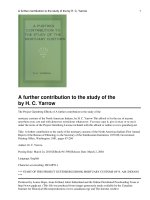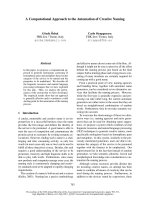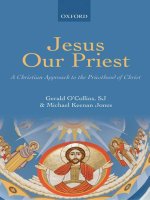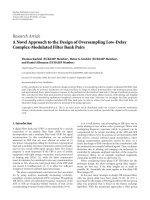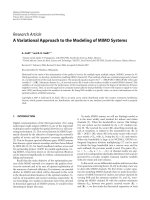princeton university press religious experience reconsidered a building-block approach to the study of religion and other special things oct 2009
Bạn đang xem bản rút gọn của tài liệu. Xem và tải ngay bản đầy đủ của tài liệu tại đây (799.79 KB, 229 trang )
Religious Experience Reconsidered
This page intentionally left blank
Religious Experience Reconsidered
-
Ann Taves
Copyright © 2009 by Princeton University Press
Requests for permission to reproduce material from this work
should be sent to Permissions, Princeton University Press
Published by Princeton University Press, 41 William Street,
Princeton, New Jersey 08540
In the United Kingdom: Princeton University Press, 6 Oxford Street,
Woodstock, Oxfordshire OX20 1TW
All Rights Reserved
L C C--P D
Taves, Ann, 1952–
Religious experience reconsidered : a building-block approach to the
study of religion and other special things / Ann Taves.
p. cm.
Includes bibliographical references and index.
ISBN 978-0-691-14087-2 (alk. paper)
1. Experience (Religion) 2. Meaning (Philosophy)—Religious aspects.
I. Title.
BL53.T39 2009
204'.2—dc22 2009006059
British Library Cataloging-in-Publication Data is available
This book has been composed in Sabon
Printed on acid-free paper. ∞
press.princeton.edu
Printed in the United States of America
10 9 8 7 6 5 4 3 2 1
To Ray, with love
This page intentionally left blank
Contents
List of Illustrations and Tables ix
Acknowledgments xi
Preface xiii
I
The Problem of “Religious Experience” 3
Experiences Deemed Religious 8
Previous Work 9
The Argument 12
Why an Attributional Approach Is Better 14
C O
Religion: Deeming Things Religious 16
The Sui Generis and Ascriptive Models of “Religious Experience” 17
Deeming Things Religious 22
Special Things and Things Set Apart 28
Setting up Research 48
Conclusion: A Four-Fold Matrix 53
C T
Experience: Accessing Conscious Behavior 56
Clarifying the Concept 58
Accessing Experience 63
Representation and Experience Revisited 73
Conclusion 86
C T
Explanation: Attributing Causality 88
Attribution Theory: An Overview 90
An Attributional Theory of Religion 94
Four Levels of Analysis and Attribution 111
Conclusion 118
C F
Comparison: Constructing an Object of Study 120
Comparing Experiences 121
Specifying a Point of Comparison 126
Comparing Simple and Composite Formations 129
Imagination and Reality 156
C
Religions: A Building-Block Approach 161
Building Blocks 162
Religions as Composite Formations 164
Implications 165
A
Appendix A: General Attribution Theory of Religion 169
Appendix B: Personal Accounts of Stephen Bradley and
William Barnard
172
Appendix C: Preliminary Thoughts on the Elaboration of
Composite Formations
176
Glossary 181
Works Cited 183
Name Index 203
Subject Index 207
viii • Contents
Illustrations and Tables
I
1.1. Various Kinds of Special Things 45
1.2. Breakdown of the Composite Ascription: Special Paths 47
2.1. Conscious and Unconscious Processes in Dream
Generation 77
2.2. Hobson’s AIM Model of Consciousness 78
4.1. Examples of Ordinary and Special Dreams 128
4.2. Two Clusters of Experiences Associated with Sleep
Paralysis 135
4.3. “This Do in Remembrance of Me” as Composite
Ascription 141
T
1.1. Methodological Differences between the Sui Generis and
Ascription Models 18
1.2. Beliefs, Ascriptions, and Attributions Related to Special
Things 46
1.3. Variations in the Nature of Experience by Ascriptive Unit
and Type of Ascription 53
2.1. Types of Data that Can Be Gathered Relative to Experience 69
3.1. Explanations at Different Levels of Analysis 113
4.1. Types of Comparisons 129
4.2. Perspectives of Emic and Etic Observers on the Experiences
of Subjects 157
This page intentionally left blank
Acknowledgments
Although I have been preoccupied with the problem of religious experi-
ence for some time, the decision to write this particular book emerged
in the wake of the Evolution of Religion Conference held in Hawaii in
January 2007, where I was asked to give one of the plenary addresses.
I am grateful to Joseph Bulbulia, Armin Geertz, and the other members
of the organizing committee for providing an occasion for articulating
my thoughts about studying “religious experience.” I am also grateful to
colleagues who provided important feedback on early drafts of chapters,
including Tom Tweed and Ilkka Pyysiäinen on chapter 1, Robert Sharf
on chapter 2, and Wayne Proudfoot and William Barnard on chapter
3. During Winter Quarter 2008, the students in my doctoral seminar—
Robert Borneman, Jared Lindahl, Andrew Manseld, Andrea Neuhoff,
Albert Silva, and Kristy Slominski—hammered away at the rst draft of
the manuscript, especially the rst chapter. Their feedback was invaluable
and much of it has been incorporated in the nal revision. In the Spring
Quarter, Todd Foose and Brian Zeiden, my teaching assistants for an
undergraduate course in psychology and religion, went over much of the
material with me in another format. I am grateful to Melinda Pitarre for
assistance in the coding of the personal narratives in chapter 3 and with
the bibliography. Bill Christian, visiting professor at the University of
California, Santa Barbara, during Spring Quarter, enthusiastically plied
me with examples of “singularization” and “special things,” and a con-
ference on Religious Ritual, Cognition, and Culture at the University of
Aarhus in May 2008 provided the occasion for further testing and revi-
sion of these ideas.
Special thanks are due to Fred Appel, my editor at Princeton University
Press, and my husband, Ray Paloutzian, both of whom have read, edited,
and commented on numerous drafts of every chapter. Fred, as the Press’s
senior editor for religion, music, and anthropology, made sure that the
book was intelligible to humanists, while Ray, as a psychologist and a
journal editor, did the same for the scientists. As an editorial tag team that
saw eye to eye on questions of style, their concerted efforts made this a
vastly more readable book. Several colleagues also read the whole manu-
script and provided detailed feedback, including Catherine L. Albanese,
my department chair, and two readers for Princeton University Press, one
of whom was Tanya Luhrmann. Their suggestions, which I have done
my best to incorporate in the nal draft, polished it yet further. I would
also like to thank my production editor, Heath Renfroe, and copyeditor,
Jon Munk, for the skill and care with which they moved the manuscript
through production.
Since Ray and I met just as I was starting to write and married days
after the rst draft was completed, I am grateful to him for much more
than reading and editing. As my companion and conversation partner in
all aspects of life, I dedicate this book to him.
xii • Acknowledgments
Preface
For reasons of temperament and training, I nd it natural and exciting to
make forays across what many scholars see as an unbridgeable divide be-
tween the humanities and the natural sciences. I must admit to a certain
impatience with those of my fellow humanists who police these boundar-
ies and caution against serious engagement with the natural sciences. In
my view, it is better to construct rough and ready bridges than to wait for
the construction of a perfect bridge that will stand for all time. This book
is devoted to building some usable, albeit imperfect, bridges linking the
study of experience in religious studies, the social-psychological study of
the mind, and neuroscientic study of the brain.
I have written this book primarily for humanists and humanistically
oriented social scientists who study religion using historical and ethno-
graphic methods. My hope is that the conceptual tools provided here will
embolden these readers to make greater use of scientic research that is
illuminating the complex ways in which the brain-mind is both shaped
by and shapes socio-cultural processes. I also hope that this book will
be useful to experimentalists who study religion—to help them consider
ways in which the resources of the humanities might enhance their exper-
imental research designs or provide new contexts for testing hypotheses.
The focus of the book is on experiences deemed religious (and, by
extension, other things considered special) rather than “religious expe-
rience.” This shift in terminology signals my interest in exploring the
processes whereby experiences come to be understood as religious at
multiple levels, from the intrapersonal to intergroup. To understand these
processes, I argue that we need to work comparatively, but that we can-
not limit our comparisons to “religious things,” as if “religious things”
or “religious experiences” comprised a xed and stable set. Rather, much
as scientists compare experimental and control groups, we need to com-
pare things that people consider religious with similar things that they
do not. The phrase “experiences deemed religious” is contentious, as is
each of the individual words “experience,” “deemed,” and “religious.” A
chapter is devoted to each word, starting with “religion,” and followed
by “experience” and then “explanation,” which takes up “deeming.” The
fourth chapter—devoted to comparison—discusses how we might best
set up comparisons between experiences that are sometimes considered
religious and sometimes not.
Scholars of religion regularly raise certain objections to the approach
I am advocating. First, they suggest that the subject matter is passé in
an era that has abandoned experience for discourse about experience.
Second, they worry that an approach that compares religious and nonre-
ligious things will wind up being reductionistic—that is, it will “reduce”
religion to something else. And, third, they offer critiques of scientic
methods and claims drawn from science studies. While I do not deny
the many legitimate concerns humanists have raised relative to scientic
methods and claims, I do not think these concerns should stop us from
engaging with research on the other side of the academic divide.
The book addresses the subject of religious experience directly and
the problems of reductionism and humanistic fears of the sciences indi-
rectly and by example. The orientation of the book is practical more than
philosophical. In the process of identifying methods that will allow us to
cross back and forth across this humanistic/scientic divide more easily
and responsibly, I draw from work in religious studies, anthropology,
history, philosophy of science, psychology, and neuroscience. In doing so,
I sidestep contentious issues where possible, privileging method over the-
ory and philosophy in the interests of actually crossing the divide, while
alerting readers to the unresolved philosophical and theoretical issues
in the notes.
1
The book is not intended to address all the thorny issues
surrounding “religious experience” but is designed to alert researchers to
some of the most hotly contested issues and to provide suggestions for
dealing with those that directly affect the way we set up and conduct our
research.
The book presupposes that we humans are reexively conscious bio-
logical animals—that is, animals who are not only consciously aware,
but aware of being aware. This means that our experience can be studied
both as a biological phenomenon from the science side of the divide and
as a subjective phenomenon from the humanistic side. The book is writ-
ten for those interested in taking both perspectives into account to de-
velop a naturalistic understanding of experiences deemed religious. Such
a pursuit does not rule out religious understandings of experience that are
compatible with a naturalistic approach, but it does not develop them.
My own view is that the cultivation of some forms of experience that we
might want to deem religious or spiritual can enhance our well-being and
our ability to function in the world, individually and collectively. Identi-
fying those forms, however, is not the purpose of this book.
2
My eagerness to get on with the task is fueled by a long-standing set
of interdisciplinary interests. Although trained as a historian of religion
1
For a different approach to bridging the divide between the sciences and humanities
that addresses humanistic fears more directly, see Slingerland (2008).
2
For a discussion of spirituality from a naturalistic perspective, see Flanagan (2007) and
Van Ness (1996).
xiv • Preface
with a particular focus on Christianity in the modern era, I was origi-
nally drawn into the eld through discussions of theory and method, an
interest I have maintained throughout my career. I was able to integrate
those interests, or at least bring them into conversation with one another,
in my book Fits, Trances, and Visions, which traced the history of the
interaction between experiencing religion and medical and psychological
explanations of experience over time.
Though this was not its overt focus, Fits, Trances, and Visions was
inspired by the realization that there are commonalities between multiple
personality, possession trance, and religious inspiration that are rooted
in capacities of the mind, and that new insights could be generated by
comparing the similarities and differences between them. This compari-
son, which has continued to fascinate me, led to further work across the
disciplines of psychiatry, anthropology, psychology, and religious studies
over the past decade and in the process generated the methodological
reections that make up the present book.
My particular interest in and preoccupation with unusual sorts of ex-
periences has inuenced the choice of examples presented in this book.
There is no reason, however, why this bias should preclude using the
approaches recommended here to study more ordinary types of experi-
ence. So, too, the traditions engaged reect my own range of expertise.
As the metaphor of rough and ready bridges is intended to suggest, I do
not intend this book to be the last word on anything, including matters
of method. I do hope, however, that it will foster a collaborative spirit
among those interested in working across the humanities/sciences divide
and an interest in testing and rening methods and theories in an effort
to enhance our collective understanding of things deemed religious.
Preface • xv
This page intentionally left blank
Religious Experience Reconsidered
This page intentionally left blank
I N T RO D U C T I O N
The Problem of “Religious Experience”
The idea of “religious experience” is deeply embedded in the study of
religion and religions as it (religion) and they (religions) have come to be
understood in the modern West. In the nineteenth and twentieth centu-
ries, many modernizers in the West and elsewhere advanced the idea that
a certain kind of experience, whether characterized as religious, mystical,
or spiritual, constituted the essence of “religion” and the common core of
the world’s “religions.” This understanding of religion and the religions
dominated the academic study of religion during the last century. Key
twentieth century thinkers, such as Rudolf Otto, Gerardus van der Leeuw,
Joachim Wach, Mircea Eliade, and Ninian Smart, located the essence of
religion in a unique form of experience that they associated with distinc-
tively religious concepts such as the sacred (Eliade 1957/1987), the numi-
nous (Otto 1914/1958), or divine power (van der Leeuw 1933/1986).
This approach has been heavily criticized over the last thirty-ve years
on two major grounds. First, it sets religious experience up as the epit-
ome of something unique or sui generis,
1
which must be studied using
the special methods of the humanities. As a unique
sort of experience,
they argued that scholars should privilege the views of believers (the rst
person or subjective point of view) and should not try to explain their
experiences in biological, psychological, or sociological terms for fear of
“reducing” it to something else. Second, it constituted religion and the
religions as a special aspect of human life and culture set apart from other
aspects. Critics claimed that this approach isolated the study of religion
from other disciplines (Cox 2006), masked a tacitly theological agenda of
a liberal ecumenical sort, and embodied covert Western presuppositions
about religion and religions (McCutcheon 1997; Sharf 1998; Fitzgerald
2000a; Masuzawa 2005).
The critics are basically right about this. Around 1900, that is, at the
height of the modern era, Western intellectuals in a range of disciplines
were preoccupied with the idea of experience (Jay 2005). This spilled
over into theology and the emerging academic study of religion where
thinkers with a liberal or modernist bent, mostly Protestant and a few
1
“Sui generis” is a Latin phrase meaning “of its own kind.” It refers to a person or thing
that is unique, in a class by itself (The New Dictionary of Cultural Literacy, 3rd ed. 2002).
4 • Introduction
Catholic, turned to the concept of religious experience as a source of
theological authority at a time when claims based on other sources of
authority—ecclesiastical, doctrinal, and biblical—were increasingly sub-
ject to historical critique. For modernist theologians who followed in the
steps of the liberal Protestant theologian Friedrich Schleiermacher, the
self-authenticating experience of the individual seemed like a promising
source of religious renewal, less vulnerable to the acids of historical criti-
cal methods (Proudfoot 1985; Sharf 1999; Jay 2005; Taves 2005).
2
Early twentieth-century liberal Christian theologians, such as Rudolf
Otto, Nathan Söderblom, and Friedrich Heiler, placed the experience
of the numinous, sacred, or holy at the center of Christianity and, by
extension, at the center of all other religions as well.
3
Hindu and Bud-
dhist modernizers, such as Sarvepalli Radhakrishnan and Daisetz Te-
itaro Suzuki, made similar moves relative to their own traditions, using
the idea of experience to undercut traditional sources of authority and
interpret traditional concepts in new ways amidst the cross-currents of
colonialism, westernization, and nationalist self-assertion. While main-
taining the centrality of their own traditions, each used the notion of
experience to underscore what they viewed as the essence of all religions
(Taves 2005).
It was in this context that the Harvard psychologist William James
gave the Gifford Lectures at the University of Edinburgh in 1902. These
lectures, which were immediately published as The Varieties of Religious
Experience, not only dened religion in terms of religious experience—
that is, as “the feelings, acts, and experiences of individual men in their
solitude, so far as they apprehend themselves to stand in relation to what-
ever they may consider divine” (James 1902/1985, 34)—but popularized
what had been a predominantly Protestant concept as a core feature of
religion in general (Taves 1999, 271). While James was responsible in
many ways for initiating the turn to religious experience in the psychol-
ogy of religion and religious studies, he did not—like so many who fol-
lowed him—claim that religious experience was sui generis and refuse
to explain it in psychological or sociological terms. Indeed, his aim as a
2
We can and should distinguish between “religious experience” as an abstract concept,
which has played a prominent role in modern religious thought, and “religious experiences”
(in the plural) as specic behavioral events, which I refer to in what follows as “experiences
deemed religious.” The conation of these two usages has created a great deal of confusion
in the eld.
3
Otto, Heiler, and Söderblum were all Protestant theologians and early historians of
religion, who followed the great liberal Protestant theologian Friedrich Schleiermacher in
dening religion in terms of experience largely independent of doctrine and institution,
resisted psychological interpretations of experience, and limited comparisons to religious
phenomena.
“Religious Experience” • 5
psychologist was to explain religious experience in psychological terms,
while at the same time leaving open the possibility that it pointed to
something more (Taves, 2009a).
Although James should not be grouped with those who argued for a
sui generis understanding of religion, his denition privileged experience
of a particular sort over religious doctrine, practice, or institutions. In
privileging sudden, discrete authenticating moments of individual experi-
ence (such as revelations, visions, and dramatic conversion experiences)
over ordinary, everyday experience or the experience of groups, he intro-
duced a bias toward sudden, individual experience that not only shaped
the contemporary Western idea of religious experience but also related
concepts such as mysticism and spirituality as well.
The prominent twentieth-century scholars of religion already men-
tioned—Gerardus van der Leeuw, Joachim Wach, Mircea Eliade, and Nin-
ian Smart—built on this turn-of-the-century emphasis on experience to
formulate their understanding of religion and the distinctive phenomeno-
logical methods they thought should be used to study it. In the wake of the
general linguistic turn within the humanities, however, this entire approach
was called into question. Many scholars of religion, eager to deconstruct
an essentialist understanding of religion and religious experience, aban-
doned the focus on religious experience and recast the study of religion in
light of critical theories that emphasize the role of language in constituting
social reality in the context of relationships of power and inequality (Sharf
1998; Braun and McCutcheon 2000; Jensen 2003; Fitzgerald 2000b; Mc-
Cutcheon 2002).
4
Scholars have now traced the history of these concepts
in Western thought (deCerteau 1995; Jantzen 1995; Scharf 1999; Schmidt
2003, Jay 2005; Taves 2005), their appropriation by turn-of-the-century
4
The linguistic or cultural turn refers to the application of insights drawn from linguis-
tics, literary criticism, and cultural anthropology to a range of disciplines in the humanities,
where it has been well received, and the social sciences, where it has been highly contested.
This approach, which is part of a general postmodern critique, stresses the ways in which
language shapes knowledge and treats all truth claims, including scientic ones, as forms
of discourse that constitute social reality through relationships of power and inequality. In
so doing, it privileges authorial virtuosity, while challenging natural and social scientic
claims to generate generally valid, shared knowledge (Bonnell and Hunt 1999, 1–27). This
shift in approach is evident in the entries on “Religion” in the rst and second editions of
the fteen-volume Encyclopedia of Religion. In the rst edition (1987), Winston L. King
dened religion as “the organization of life around the depth dimensions of experience” and
struggled to distinguish distinctively religious depth experiences from nonreligious ones, de-
ciding rather circularly that “the religious experience is religious precisely because it occurs
in a religious context” (2005, 7695–96). The supplementary entry written by Gregory D.
Alles for the second edition (2005) highlights the intense criticism directed toward deni-
tions of this sort and the scholarly shift from “trying to conceptualize religion to reecting
on the act of conceptualization itself” (2005, 7702) that ensued.
6 • Introduction
intellectuals with modernist inclinations in other parts of the world such
as India and Japan (Halbfass 1988; Sharf 1995; King 1999), and their use
by missionaries in colonial contexts (Chidester 1996, Fitzgerald 2007b).
These studies, although well integrated with efforts at deconstruction
across the humanities, are usually isolated from efforts to understand re-
ligion in the natural sciences. Indeed, those who embrace critical theory
within the humanities and social sciences have typically been more inter-
ested in deconstructing scientic efforts than in bridging between science
and critical theory (Wiebe 1999; Slingerland 2008).
Scholars in anthropology, sociology, and psychology—disciplines that
we might expect to serve as bridges between the humanities and natural
sciences—have faced various difculties in that regard. Within mainstream
anthropology of religion, the primary focus has been on shamanism and
spirit-possession with far less attention paid to so-called world religions,
particularly Christianity (Cannell 2006). In reciprocal fashion, religious
studies has focused for the most part on “high religions” with “gods” and
relegated the study of shamanism and spirits—that is, “folk religion ”—to
anthropology (Mageo and Howard 1996; Mayaram 2001). Although
William James and his collaborators in the Society for Psychical Research
thought of spirit-possession and mediumship as intimately related to the
broader realms of religion and religious experience, they downplayed
those connections in their published work and were not able to overcome
the emerging division of labor between religious and theological studies,
on the one hand, and the anthropology of religion, on the other (Kenny
1981; Taves, 2009a). Given this twentieth-century division of labor, schol-
ars have tended to use terms such as “religious experience,” “mysticism,”
and “spirituality” with reference to so-called “high” religions but not as
commonly in relation to “folk” or “primitive” religion.
In terms of its orientation to the humanities and natural sciences, an-
thropology has been divided right down the middle. More than any other
discipline, anthropology has been a battleground in the methodological
wars between critical theorists oriented toward the humanities and social
scientists oriented toward the natural sciences. While race and gender
have been the most hotly contested issues, any attempt to bring science
into the humanities and critical theory into science can raise suspicions
among anthropologists (Slingerland 2008). There are pockets, however,
within anthropology—psychological anthropology and medical anthro-
pology in particular—that do bridge the humanistic and the natural sci-
ences, and there is some exciting new work being done on religion in these
subelds (e.g., Luhrmann 2004, 2005). Generally speaking, mainstream
anthropological research on shamanism and spirit-possession has exem-
plied the tension between reductionistic, naturalistic, or medical models,
on the one hand, and phenomenological, contextualizing cultural -studies
“Religious Experience” • 7
approaches, on the other (Boddy 1994), although here, too, a few an-
thropologists have made innovative efforts to bridge the gap between the
natural sciences and the humanities (Stephen 1989).
Although some sociologists, especially those following in the tradition
of Emile Durkheim, have attended to collective and in some cases even
individual experience, they have focused on the social causes and effects
of experience apart from the psychological and biological. In general,
psychologists and sociologists of religion have distinguished between the
private religious experience of individuals and the public religiosity of
organized groups, with psychologists of religion focusing on the former
and sociologists of religion on the latter. Although there is some newer
work (e.g., Bender 2008) that runs counter to these trends, psychologists
of religion have devoted far more attention to religious experience than
sociologists.
Due to their focus on religious experience, including spirituality and
mysticism, the relationship between the psychology of religion and the
general eld of psychology is parallel in some respects to the relation-
ship between religious studies and other disciplines. Although research
in the psychology of religion is conducted across the whole array of sub-
elds within psychology running the gamut from the natural to the social
sciences (see Paloutzian and Park 2005), psychologists of religion, like
scholars of religion, have wrestled with the question of whether religion
is unique among human behaviors or can be accounted for using the re-
search methods and/or explanatory principles that are applied to human
behavior more generally (Baumeister 2002). Those who claimed that re-
ligion is in some sense unique (sui generis) have resisted “reductionistic”
approaches to the psychology of religion and maintained the need for
distinct approaches that set it apart from the rest of psychology (Dittes
1969, Pargament 2002).
While the psychology of religion, like religious studies, has been through
a long period of critical self-reection, some within the eld now advocate
a “multilevel interdisciplinary paradigm” (Emmons and Paloutzian 2003)
that would allow the psychology of religion to “reach out to evolutionary
biology, neuroscience, anthropology, cognitive science, and . . . philoso-
phy in a generalized cross-disciplinary approach to critiquing and sharp-
ening the assumptions of science” (Paloutzian and Park 2005a, 7–9). The
multilevel interdisciplinary paradigm would thus link “subelds within
psychology as the core discipline in a broader effort.” This new paradigm
undercuts the old binary distinction between reductionism and unique-
ness, reframing it in relation to theories of emergence in which emergent
properties, such as consciousness and group leadership, are understood
to emerge at different levels of analysis (ibid). Experience—whether reli-
gious, spiritual, or mystical—is denitely a phenomenon for study within
8 • Introduction
this new paradigm, but the implications of the paradigm for setting up
experientially related objects of study that can be examined across dis-
ciplines have not been adequately worked out. Without further rene-
ment at the design stage, it will be difcult to connect different lines of
research.
Finally, in the last decade and a half (since 1990), there has been a
dramatic increase in studies examining the neurological, cognitive, and
evolutionary underpinnings of religion in light of the rapid advances in
the study of the brain and consciousness. Scholars who identify with the
growing subeld of the cognitive science of religion are drawn from dis-
parate disciplines including psychology, anthropology, religious studies,
and philosophy. Though most of them are well versed in the study of
religion, they have focused on belief and practice (ritual) and with a few
exceptions, such as Azari (2004) and Livingston (2005), have ignored
experience (for an overview, see Sloan 2006). In addition, scholars and
researchers, including a number of self-identied neurotheologians, most
of whom lack training in theology or religious studies (e.g., D’Aquili and
Newberg 1999), have enthusiastically embraced the challenges of identi-
fying the neural correlates of religious experience without engaging the
critiques of the concept that led many scholars of religion to abandon it.
After decades of critical discussion of the concept, we can neither sim-
ply invoke the idea of “religious experience” as if it were a self-evidently
unique sort of experience nor leave experience out of any sensible ac-
count of religion. How, then, should we understand “religious experi-
ence”? Given the critiques of the last several decades, is there any way the
concept can be studied by those interested in understanding such experi-
ences naturalistically?
E D R
Rather than abandon the study of experience, we should disaggregate
the concept of “religious experience” and study the wide range of experi-
ences to which religious signicance has been attributed. If we want to
understand how anything at all, including experience, becomes religious,
we need to turn our attention to the processes whereby people sometimes
ascribe the special characteristics to things that we (as scholars) associ-
ate with terms such as “religious,” “magical,” “mystical,” “spiritual,” et
cetera. Disaggregating “religious experience” in this way will allow us to
focus on the interaction between psychobiological, social, and cultural-
linguistic processes in relation to carefully specied types of experiences
sometimes considered religious and to build methodological bridges
across the divide between the humanities and the sciences.



